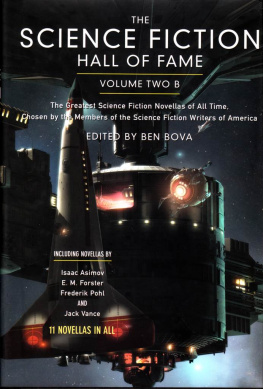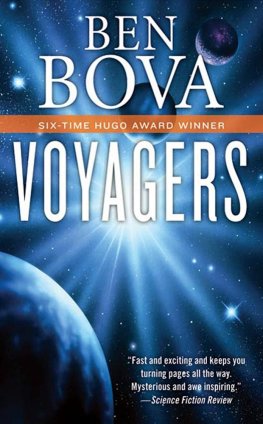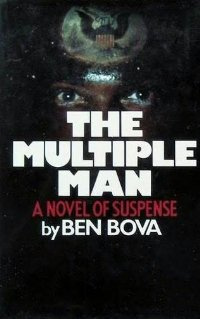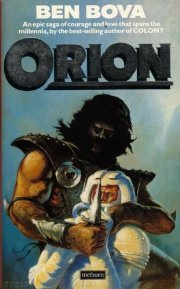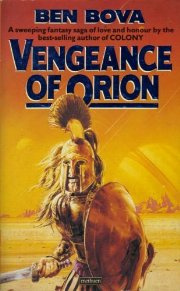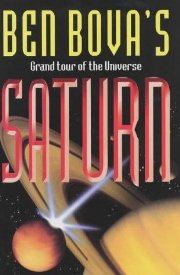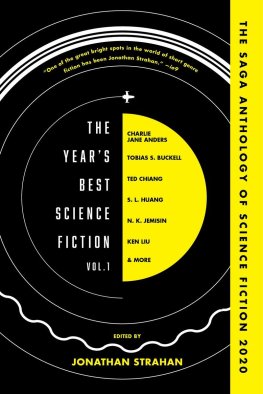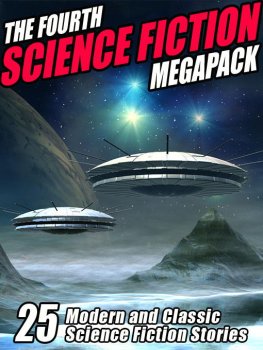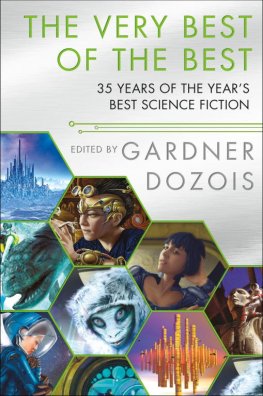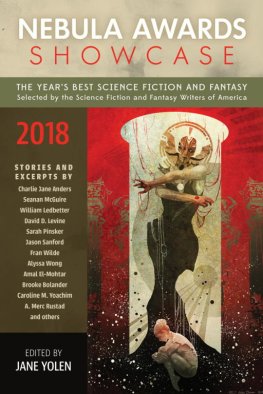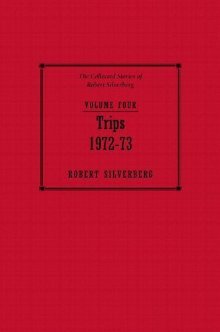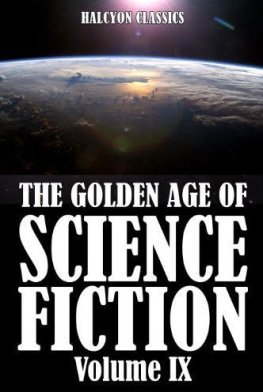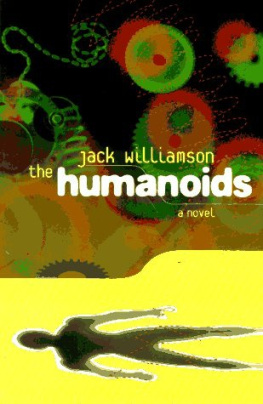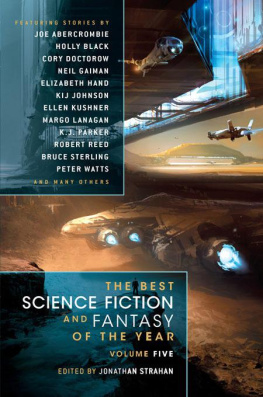
cover
THE
SCIENCE FICTION
HALL OF FAME
Volume Two B
The Greatest Science Fiction Novellas of All Time
Chosen by the Members of
The Science Fiction Writers of America
Edited by Ben Bova
TOR*
A Tom Doherty Associates Book New York
This is a work of fiction. All of the characters,organizations, and events portrayed in these novellas are either products ofthe authors' imaginations or are used fictitiously.
THE SCIENCE FICTION HALL OF FAME: VOLUME TWO B
Copyright 1973 by The Science Fiction Writers ofAmerica
Originally published by Doubleday & Company, Inc.
All rights reserved, including the right to reproducethis book, or portions thereof, in
any form.
A Tor Book
Published by Tom Doherty Associates, LLC
175 Fifth Avenue
New York, NY 10010
www.tor.com
Tor is a registered trademark of Tom DohertyAssociates, LLC.
ISBN-13: 978-0-7653-0532-9 ISBN-10: 0-7653-0532-1
First Tor Edition: May 2008
Printed in the United States of America
098765 43 2 1
An ebookman scan.
ACKNOWLEDGMENTS
The Martian Way, by Isaac Asimov, copyright 1952 byGalaxy Publishing Corporation. Reprinted by permission of the author.
Earthman, Come Home, by James Blish, copyright 1953by Street & Smith Publications, Inc. Reprinted by permission of the authorand his agent, Robert P. Mills, Ltd.
Rogue Moon, by Algis Budrys, copyright 1960 byAlgis Budrys. Reprinted by permission of the author and his agent, theLantz-Donadio Literary Agency.
The Spectre General, by Theodore Cogswell, copyright 1952 by Street & Smith Publications, Inc. Reprinted by permission of theauthor.
The Machine Stops, by E. M. Forster, from TheEternal Moment and Other Stories by E. M. Forster, copyright 1928 byHarcourt Brace Jovanovich, Inc.; copyright renewed 1956 by E. M. Forster.Reprinted by permission of Harcourt Brace Jovanovich, Inc.
The Midas Plague, by Frederik Pohl, copyright 1954by Galaxy Publishing Corporation. Reprinted by permission of the author.
The Witches of Karres, by James H. Schmitz, copyright 1949 by Street & Smith Publications, Inc. Reprinted by permission of theauthor and his agents, Scott Meredith Literary Agency, Inc.
E for Effort, by T. L. Sherred, copyright 1947 byStreet & Smith Publications, Inc., copyright 1972 by T. L. Sherred aspart of the collection, First Person Peculiar. Reprinted by permissionof the author and his agent, Virginia Kidd.
In Hiding, by Wilmar H. Shiras, copyright 1948 byStreet & Smith Publications, Inc. Reprinted by permission of the author.
The Big Front Yard, by Clifford D. Simak, copyright 1958 by Street & Smith Publications, Inc. Reprinted by permission of theauthor and his agent, Robert P. Mills, Ltd.
The Moon Moth, by Jack Vance, copyright 1961 by GalaxyPublishing Corporation. Reprinted by permission of the author and his agents,Scott Meredith Literary Agency, Inc.
CONTENTS
INTRODUCTION by BenBova
This two-book set is the second volume of the ScienceFiction Hall of Fame, and consists of stories of longer lengths than thosepublished in the highly acclaimed Volume One.
These stories have been selected by the members of theScience Fiction Writers of America (SFWA), the organization of some fourhundred professional science fiction writers. Thus, the Science Fiction Hall ofFame is the definitive anthology in this field, the collective choice of thepractitioners of the science fiction art themselves.
Founded in 1965, each year since 1966 SFWA has givenachievement awards for the best stories of the year. The awards are calledNebulas, and are chosen on the basis of a vote by SFWA's members. The purposeof the Science Fiction Hall of Fame anthologies is to bestow a similarrecognition on stories that were published prior to 1966, and thus never had a chanceto earn a Nebula.
Like the annual Nebula awards themselves, election to theHall of Fame anthology is based on a poll of SFWA's members. Volume One wasrestricted to short stories; Volume Two is devoted to novelettes and novellas.
The voting procedure began with recommendations. For nearlya full year, SFWA members sent in suggestions for stories that were worthy ofinclusion in the Hall of Fame. As editor, I quickly began to see that it wasgoing to be a heartbreaking job to rule out any of these fine tales.Almost every title recommended brought back a powerful memory of the first timeI had read that particular piece. And the authors! H. G. Wells, John W.Campbell, Jr., Robert Heinlein, Cyril Kornbluth... how could any of them beruled out?
A ballot was finally prepared, consisting of seventy-sixrecommended stories. The SFWA members were asked to vote for ten stories out ofthe seventy-six. Since many authors had more than one story on the ballot, andwe didn't want any individual author to be represented more than once in theanthology, the members were further asked to vote for only one story perauthor.
Many of the ballots came back with screams of despair andfrustration scribbled over them. "How can I pick only ten of 'em?"was the typical cry. Most of the members wanted most of the recommended storiesto go into the final anthology.
When the votes were counted, the top ten stories were: who goes there? by John W. Campbell,Jr. A canticle for leibowitz byWalter M. Miller, Jr. with folded hands byJack Williamson the time machine byH. G. Wells baby is three by Theodore Sturgeon vintage season by Henry Kuttner and C.L. Moore the marching morons byC. M. Kornbluth universe byRobert A. Heinlein by his bootstraps byRobert A. Heinlein nerves byLester del Rey
Since several authors had more than one story on the ballot,and thus were in the unhappy position of competing with themselves, I slicedthe pie in the other direction, too, and looked for the ten most popularauthors: Robert A. Heinlein Theodore Sturgeon John W. Campbell, Jr. Walter M.Miller, Jr. Lester del Rey C. M. Kornbluth Jack Williamson H. G. Wells PoulAnderson Henry Kuttner and C. L. Moore
The procedure for picking the stories to go into theanthology, then, was fairly straightforward, since most of the top authors werealso represented among the most popular stories. I prepared a list of storiesthat included the highest vote-getters among the stories and the most popularauthors. For any individual author, I picked the story of his that had receivedthe most votes.
It was much easier to start the list than end it. There wasalways the temptation to sneak in just one more storyafter all, I would tellmyself, this one's really too good to be left out. I ended with a listof twenty-two stories, totaling more than 400,000 words. Far too much for asingle book.
I took my problem to Larry Ashmead, the editorial mastermindwho presides over Doubleday's science fiction publications. It was a shamefuldereliction of duty, but I didn't have the heart to cut out any of thosetwenty-two stories. Thankfully, neither did Larry. After one look at the list,he suggested making a two-book set so that all the stories could be included.
Unfortunately, two of the storiesMiller's A Canticle forLeibowitz, and Ray Bradbury's The Firemanwere unavailable for thisanthology. Both are currently available in book form, however.
So here is the second volume of the Science Fiction Hall ofFame. It represents the best that science fiction has to offer, by some of thebest writers working in this or any field of literature.
One final note of acknowledgment and thanks. Much of theonerous work of tracking down publication dates and magazines, toting upwordage lengths, and finding copies of the original stories, was done byAnthony R. Lewis. Without his aid, this volume might still be little more thanan unfulfilled promise.

